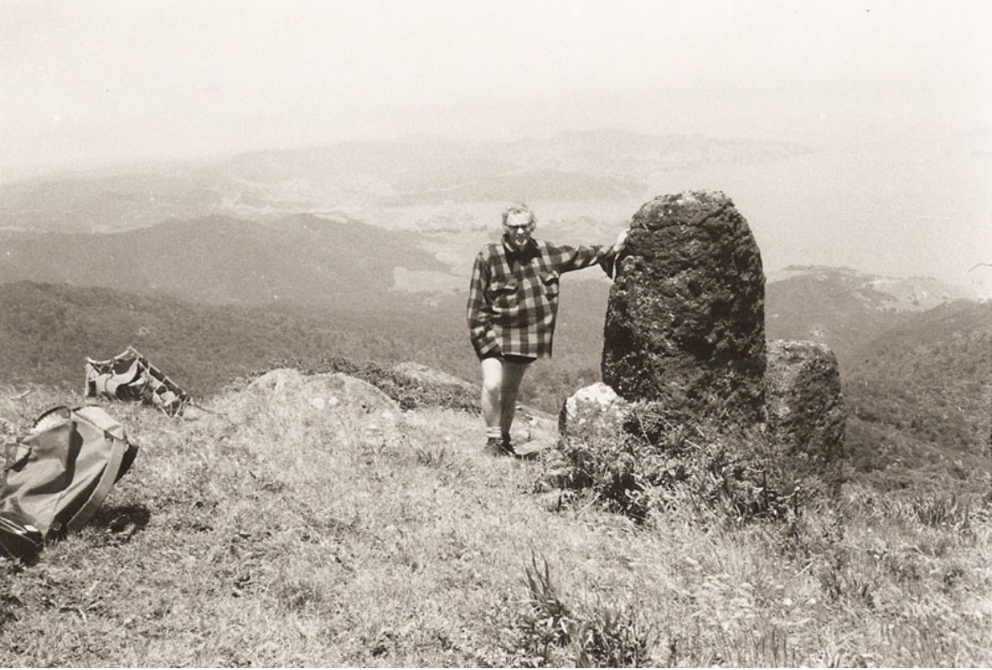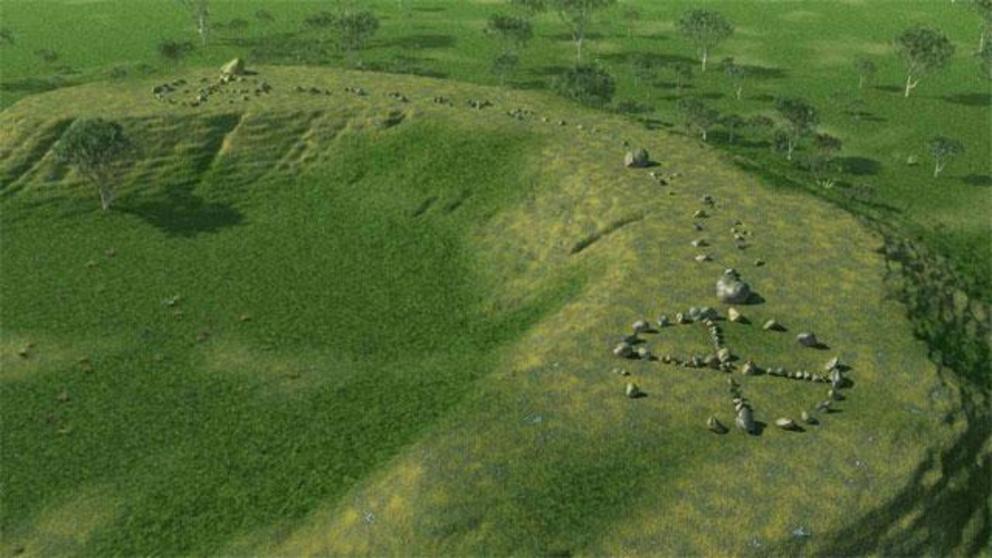Hidden and suppressed Australasian history
- an online overview

The top of Moehau Mountain on New Zealand’s Coromandel Range is crowned with an ancient standing stone trig as well as scattered satellite marker boulders, Similar markers are seen hill and mountain tops elsewhere. Photo taken in 1979 and appears on the website Celtic NZ.

A huge and laboriously carved, ancient concentric ring stone (bulls-eye design) sits on its side in the Waipoua Forest of Northland, New Zealand. This is the location of former “Beehive House” hovel dome villages, walls, altars, hearths, cupstones and many other expressions of the former Patu-paiarehe stoneworking culture.

The mysterious boomerang-shaped mound near Brunswick Heads, NSW, with computer generated imagery of the “story telling” stone structures around it.
By TONY MOBILIFONITIS
“ABORIGINES worship mound” read the headline on a short article in the Wagga Wagga Daily Advertiser, on Wednesday, August 2nd, 1939. “A mound 35ft. long and 15ft. high, which has been discovered about three miles from Brunswick Heads, is believed to have been an aborigines’ religious mound, which was a centre of worship for aborigines from all parts of Australia before the coming of the white race,” the newspaper reported.
“Access to the mound is gained by a sloping pathway on one side. It appears to have been untouched for a great many years. The president of the Archaeological Society of Australia (Mr. Frederick Slater) has deciphered many of the carvings on the sandstone, which must have been brought a considerable distance.
“There is none of it in the district. Another such mound is known to exist in North Australia. A Fraser Island aborigine when told of the discovery said that his tribe had been searching for the mound for years…”
Slater had spent time with indigenous elders deciphering symbols on stones at the site and came to the spectacular conclusion that Egyptians had contact with early Aborigines long before Europeans visited the continent. Slater believed “the ancient cult of the blackfella” developed the first language and actually influenced the religious beliefs of the Egyptians and other cultures.
“The mound is one of the oldest, I should say the oldest, forms of temples in the world, and dates back to the Palaeolithic age with the advent of first man,” Slater wrote. He believed that the most ancient of all tongues on Earth, the “Sacred Language” was first chronicled at this site.
These days little is said of the archaeological find apart from a few online articles. The farmer on whose land the rock formation in 1940 told his then 15-year-old son to destroy the site after reportedly being pressured by the government of the day.
However, a recent archaeological examination of the site was undertaken by Steven and Evan Strong who have published books on “hidden Aboriginal history”. The pair, assisted by a team, did GPS analysis of sandstone rocks scattered around the site. Sandstone is not part of the local geology and the rocks were apparently transported some distance to the site.
The Strong brothers say they both agree that the Egyptians came to Australia as apprentices, to be tutored in the esoteric insights and cultural refinements that were a part and parcel of the Australian landscape and Original philosophy. “There is no mistaking the fact that the aborigines … gave not only to the Egyptians their knowledge and their foundation of hieroglyphics and their philosophy, but formulated the basis of all knowledge in the beginning, now and to come.”
Some of the biggest rocks from the site were carefully placed inside the farmer’s barn, but were stolen within a decade. “We can only hope that person was not stealing but safeguarding the rocks until the day they can be returned, which is nearly upon us,” the Strongs noted in a comprehensive report on the site.
“Another issue under consideration is Slater’s belief an actual Original alphabet of 16 letters existed and that some of those symbols were engraved onto rocks on the bigger mound. We do know that some symbols were engraved into some of the larger rocks that were stolen or kept under safe keeping, and there are markings on rocks on site that require much closer scrutiny, but at this stage we can offer nothing conclusive,” they wrote.
Curiously, the Strongs seem to have resorted to hiding the location of the site. They describe it as being “within 40km of Mullumbimby”, when the 1939 Wagga Wagga newspaper report identifies it as being near Brunswick Heads, only 8km from the town. Unlike Slater and the local indigenous elders who helped him, some among the Strongs crew developed serious superstitious about the site, downing tools over “spiritual presences” and forbidding any digging in certain areas. It’s one thing to respect religious traditions, but another to be dominated by fear of supernatural presences.
It is a popular but dubious view that Aborigines are the oldest culture on earth, as DNA evidence suggests they, like most if not all cultures, were migrants at some stage. A major DNA study indicated about 90% of present-day Australian Aboriginals belong to the Pama-Nyungan linguistic family that originated about 6000 years ago, was concentrated in the north and linked to migrations from East Asia via the present islands Papua New Guinea.
The origin of mankind essentially involves two views, evolution or biblical creation (although some subscribe to an alien life theory). The Book of Genesis says the world repopulated after Noah’s global flood and then unified around the Tower of Babel, believed to have been a stepped ziggurat structure that was common in Babylonia and other parts of the earth. The Bible records the statement: “Come, let us build ourselves a city and a tower with its top in the heavens, and let us make a name for ourselves, lest we be dispersed over the face of the whole earth.” (Genesis 11:4)
But Jehovah foresaw the dangers of this self-aggrandizing unity and supernaturally confounded their language, and so they would disperse themselves across the earth in accordance with his instructions to the first humans in Genesis to “be fruitful and multiply and fill the earth”.
So, could those other biblical and historical people, the Egyptians, have been part of the dispersal? That they were seafaring and could have reached distant lands like Australia is not without foundation, as well-preserved oars, timber beams and ropes from 70ft sailing ships were discovered in 2004 in man-made caves on the Red Sea coast. The equipment was dated at 1500 to 1400BC in the era of Egypt’s Queen Hatshepsut. Hieroglyphics at the sites describe expeditions to trading ports Punt and to Bia-Punt, whose location is now unknown, and two officials, Nebsu and Amenhotep, who led the expeditions.
The Cairo Times reported in 1982 that archaeologists working at Fayum, near the Siwa Oasis, uncovered fossils of kangaroos and other Australian marsupials. An unexplained set of golden boomerangs was also reportedly discovered by Prof. Howard Carter in the tomb of Tutankhamen on November 11, 1922.
There are numerous other mysterious, fascinating and questionable hieroglyphic findings linking Australia to Egypt and other cultures listed at the website crystalinks.com. Some findings, such as the “Gympie pyramid” and the claims of Rex Gilroy and Brett Green are of dubious nature.
The spectacular Gosford rock wall Egyptian hieroglyphics are also questionable but apparently tell the story of ancient explorers shipwrecked in a strange and hostile land, and the untimely death of their royal leader Lord Djes-eb. A group of three framed clusters of glyphs record the name of Ra-Jedef as reigning King of the Upper and Lower Nile, and son of Khufu, son of the King Sneferu.
